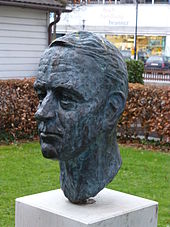Hannes Grabher
Hannes Grabher , actually Johannes Baptist Grabher , (born August 4, 1894 in Lustenau ; † January 17, 1965 ibid) was a Vorarlberg dialect and local poet . With his partly cheerful, partly contemplative poems, he is counted among the most important representatives of this art movement in Vorarlberg.
Life
Hannes Grabher was the second youngest of seven children of Johann Baptist Grabher and his wife Anna Maria geb. Grabher-Meyer born in Lustenau. After eight years of elementary school - the financial situation in his parents' house did not allow for further school education for the time being - he began his professional life and eventually became a forwarding manager for a Swiss company. During the First World War he served with the 3rd Regiment of the Tyrolean Kaiserjäger on the southern front . After the war he attended the Lustenau commercial school and worked for the Swiss company Schmidheiny from 1920 until his retirement in 1963 .
He first became famous as a track and field athlete between 1920 and 1924 (multiple national champion and national record holder, especially in the running disciplines). His nickname "Jonny" comes from this time.
In 1924 he married Maria geb. Schlachter (* 1899), with whom he had five children.
After Austria was annexed to Germany, the NSDAP tried to capture Hannes Grabher. He was commissioned to create a "village book" or a village chronicle and in a letter dated February 4, 1942, referred to it as a "party member". He was the only Lustenau resident who had permission to enter and leave Switzerland daily as a cross-border commuter during the entire Second World War . He used this special position during the war and the subsequent occupation to help other Lustenau residents, for example by getting urgently needed medication in Switzerland. He also organized the correspondence with Lustenauers in captivity and was involved in the search for missing soldiers.
On January 17, 1965, he died of a heart attack.
Artistic creation
Hannes Grabher published his first poems from 1927 in regional newspapers, including in "Feierabend" (weekly supplement to the Vorarlberger Tagblatt ), in "Hollunder" (weekly supplement to the Vorarlberger Volksblatt ) and the Ostschweizer newspaper Unser Rheintal . He wrote in dialect as well as in Standard German and Swiss German . In his partly cheerful, partly serious poems, he mainly dealt with the everyday situations, strengths and weaknesses of his fellow men. He was significantly influenced in his work by the Dornbirn dialect poet Armin Diem , with whom he was close friends from 1934.
In 1937 his first volume of poetry was published: “Lustenauer Mundart-Dichtungen”, popularly referred to as “Dar Gôuoßbock” (“The billy goat”) in allusion to the cover picture. Other volumes with dialect poems followed: "Uf om Bänkli" (1950), "So is s' Läobo" (1963), in which the serious poems dominate, and - posthumously - "Dialect poems" (1977). In 1946 he published “Der Hafner”, a collection of poems in the High German language. 1948 appeared with " 's Kremmelerb'", a comedy in which a Lustenauer local legend was processed, his only dramatic work. In 1952, together with Beno Vetter , he wrote a “Festival on the occasion of the 50th anniversary of the market town of Lustenau”.
The fruitful collaboration with the composer Georg Hering-Marsal from Dresden resulted in a series of poems set to music. It culminated in 1955 in the jointly published booklet "Huomatliedle" (with guitar accompaniment by Franzl Mayr). Other poems were set to music by the Dornbirn doctor Franz Bertolini (from "Der Hafner") and by the Lustenau church musician and choir director Erich Hollenstein (dialect poems).
His lyrical work is rounded off by the folklore book “Customs, Legends and Chronicles” presented in 1956, popularly known as “Our Customs”. It includes a collection of legends , customs , proverbs and nursery rhymes and became the standard work on Lustenau's folklore . Two other folklore writings (“The Rhine, our stream of fate” and “Sport in Lustenau”) remained unpublished.
Awards and honors
- Ring of Honor of the Municipality of Lustenau (1964)
- Memorial stone (originally in front of his birthplace, moved to Hasenfeldpark in 2007)
- Bust in a small park next to the Lustenau town hall
- Naming of Hannes-Grabher-Straße in Lustenau
Works
- Lustenau dialect poems , 1937
- Der Hafner , Poems in High German, 1946
- 's Kremmelerb' , play, 1948
- Uf om Bänkli , dialect poems, 1950
- Huomatliedle , dialect poems set to music (1955, together with Georg Hering-Marsal)
- Customs, sagas and chronicles , folklore research, 1956 (new edition 2002)
- So is it Läobo , dialect poems, 1963
- Dialect poems , 1977 (posthumous)
literature
- Wolfgang Scheffknecht: 100 years of the market town of Lustenau 1902 - 2002 A chronicle p. 366–370
- Hannes Grabher on his 125th birthday . In: Marktgemeinde Lustenau (Ed.): Lustenauer Gemeindeblatt . No. 31 , 2019, pp. 8th f . ( online [accessed August 8, 2019]).
Web links
- Literature by and about Hannes Grabher in the catalog of the German National Library
- Hannes Grabher. Market town of Lustenau
| personal data | |
|---|---|
| SURNAME | Grabher, Hannes |
| ALTERNATIVE NAMES | Grabher, Johannes Baptist (real name); Grabher, Jonny (nickname) |
| BRIEF DESCRIPTION | Austrian dialect poet |
| DATE OF BIRTH | 4th August 1894 |
| PLACE OF BIRTH | Lustenau |
| DATE OF DEATH | January 17, 1965 |
| Place of death | Lustenau |

